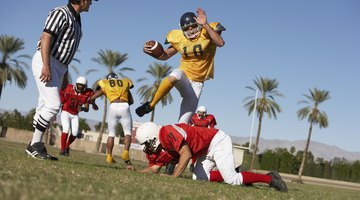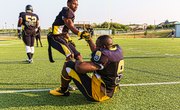The 302 Division II colleges in the United States range in size from 2,500 to 15,000 students, with an average of about 4,500 students. Division II athletics offer a mid-range competitive experience that equally emphasizes academics and athletic participation. If you’re seeking a Division II athletic scholarship, learn about the recruitment process, be informed about rules that govern scholarship awards, ensure you meet eligibility requirements and make a decision that meets both your academic needs and athletic interests.
Scholarship Opportunities
The National Collegiate Athletic Association governs the number of scholarships allowed. Division II schools can award 3.6 to 36 full scholarships for men’s sports and 5.4 to 18 full scholarships for women’s sports. These limits are imposed to ensure fair competition between college programs. Scholarship limits vary by sport. For example, Division II schools can give 3.6 scholarships for men's golf and 36 for football. Similarly, 5.4 scholarships are available for women's golf and 18 are available for women's hockey. Scholarships can be divided between individual athletes in partial amounts to stretch awards to more players. A full athletic scholarship can cover only college tuition, student fees, room, board and required books for classes.
Eligibility Requirements
To be eligible for a Division II athletic scholarship, you need to be certified as an amateur student-athlete. Some of the questions you’ll need to answer are about money you’ve received for playing sports, interaction with professional teams, prize money and contact with potential sports agents. You’ll also need to verify that you’ve graduated from high school, completed 16 core courses, received a 2.0 grade point average or greater in those courses and earned a combined SAT score of 820 or an ACT sum score of 68, a combination of the math, science, English and reading subsections of the exam. Once you’ve become qualified under these NCAA conditions, you’ll be certified to move forward in the scholarship process.
Recruitment Process
If you’re an accomplished athlete, colleges will likely seek your participation in their programs. If you’re an unknown, you may need to work harder to be considered for a scholarship. Develop a letter of interest, sports resume and video representation of your performance and submit these items to colleges so that you’re on their radar. High school coaches often have connections with Division II programs, and your coaches know your athletic potential and can provide advice about the right fit for you. Begin your search early and contact prospective coaches so that they’re aware of your interest. Visit prospective colleges and arrange a meeting with the coach. Be persistent with your interest and develop a list of questions to ask so that you’re well-informed about the college environment.
Inside Information
The NCAA has specific rules about how and when potential student-athletes can be contacted by college coaches, and these vary by sport. Become familiar with these rules to avoid problems with scholarship eligibility. For example, established time periods exist for campus contact, evaluation, non-contact and signing offers. The summer before your junior year, you can receive recruitment materials, speak to coaches on the phone, have off-campus contact with coaches and engage in unofficial visits to the campus. However, you cannot go on an official campus visit until your senior year. Rules of contact change as you progress through high school, so be sure to visit the eligibility center for the details that apply to you. Athletic scholarships are awarded for one year and can be renewed for a maximum of five years. If you lose a scholarship, you have a right to appeal.
Related Articles
References
Writer Bio
Dr. Kelly Meier earned her doctorate from Minnesota State Mankato in Educational Leadership. She is the author and co-author of 12 books and serves as a consultant in K-12 and higher education. Dr. Meier is is a regular contributor for The Equity Network and has worked in education for more than 30 years.











